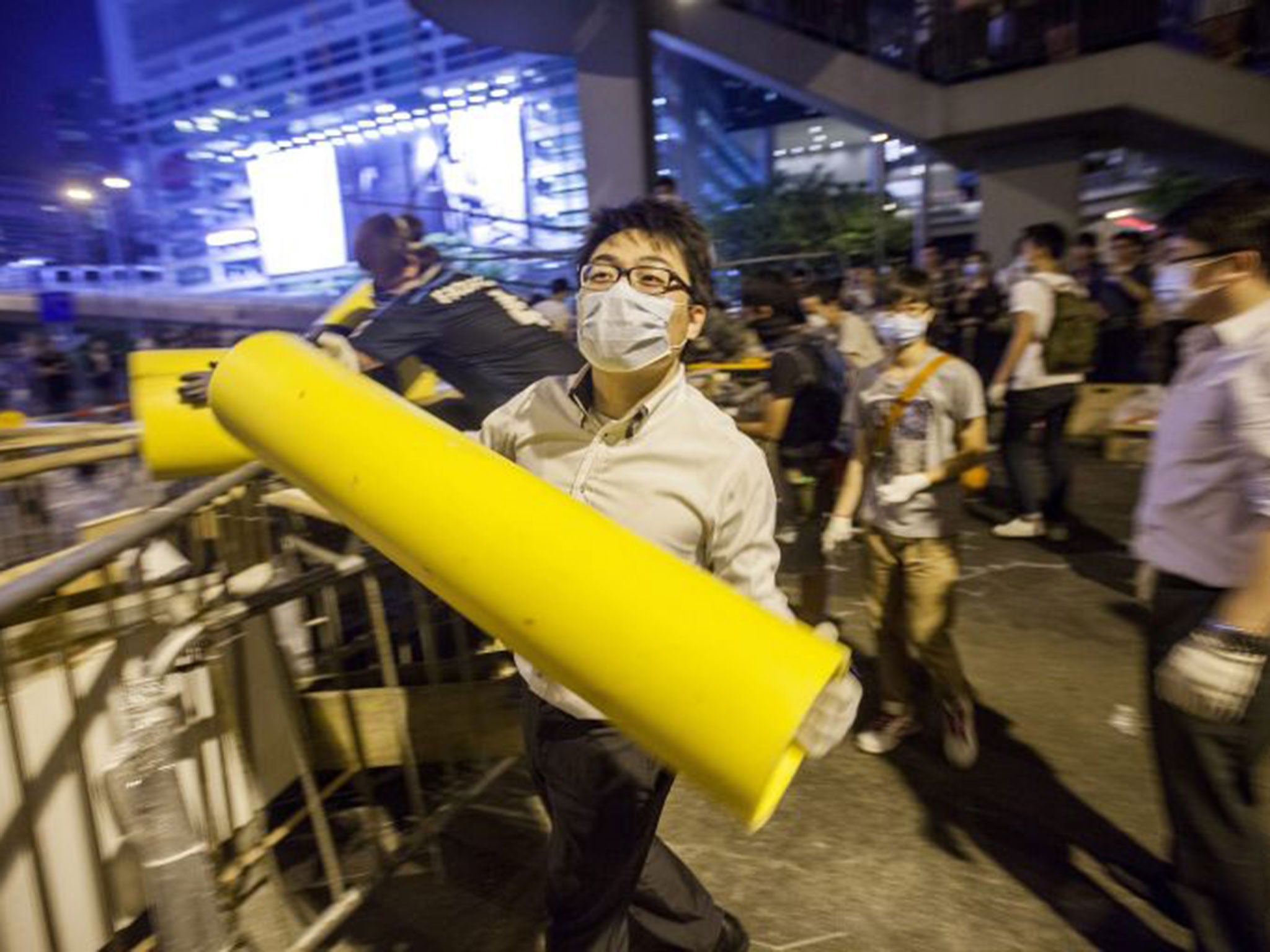Hong Kong protests: Demonstrators rebuild barricades after police and masked men attempt to rip them down
Construction work came shortly after the city’s leader said the occupation would not 'continue in the long term'

Protesters in Hong Kong last night barricaded themselves behind by far their biggest defences yet, after attempts by police and masked men to clear the barriers around their occupation site.
The construction work came shortly after the city's leader said the occupation of its political and financial hub – as well as other major shopping districts – wouldn't “continue in the long term.”
The protests, now into their third week, are against a restrictive system through which China wants the region to elect its leader in 2017, and what protesters say was a heavy-handed police response to initial, much smaller, protests on the same issue.
Early yesterday afternoon a group of men, who protesters accuse of being hired thugs with triad connections, used a crane truck to clear makeshift barricades and fought with occupiers. Up to 100 police officers were also on the scene, on the arterial road of Queensway, one block south of the main protest site of Harcourt Road.
Police said they arrested three men, aged 18 to 47, after the fracas on suspicion of assault and carrying weapons, but didn't say which side the men were on.
Occupy Central, the group which sparked but no longer claims leadership of the civil disobedience movement, denounced the police tactics and stated: “We urge the police to enforce the law and prevent certain people from damaging the peaceful occupy movement, and avoid any suspicion that the government may be trying to use the masses to attack the masses.”
The move, on the pretext of retrieving government property, was ostensibly intended to lessen the site's defences. But it only sparked a flurry of construction work, with barricades strengthened and widened beyond recognition.
Bags of cement were brought in on lorries and a construction company donated supplies of bamboo - so strong Hong Kongers still use it instead of steel scaffolding on their homes.
Wearing face masks to protect from potential teargas attacks, volunteers threw into their new structures everything that wasn't nailed down. Office chairs, bus stop signs and traffic cones were piled into structures which spanned the width of the main roads and were at some points at some points 15ft wide.
One of those volunteers was Ken Lau, a 25-year-old computer programmer who was using cling film to shore up joins in the bamboo lattice. He told The Independent the new structure was a “necessary protection” against “gangsters.” He added that: “If the government is willing to listen to the students, the protesters might be willing to leave on their own,” but said he saw no sign of that.
And 26-year-old Summer Wong, who was working on the structure at the other end of occupied Queensway, said: “I think the government is really stupid because sometimes they just think if they do something to scare people we will go, and no longer stay here. But actually, it's been 16 days. The government used teargas. Some people are paid to beat people, and we just aren't afraid,” before adding: “Actually, we are afraid, but we won't go home.”
The new fortifications came on a night that student leaders addressed a large and rapt crowd in the main protest area. Numbers have dwindled somewhat since highs of over 10,000, but at least 3,000 people listened as Lester Shum, Joshua Wong, and other leaders gave defiant and at times jovial speeches, with the crowd singing Happy Birthday to Wong, who turned 18 yesterday.
The protests, which have blocked roads in many important parts of Hong Kong, are against an election plan for 2017 under which a committee composed mainly of Beijing loyalists will have to approve candidates before citizens are allowed to vote for their next chief executive, the equivalent of a city mayor.
Demonstrators have also poured scorn on, and called for the resignation of the incumbent, Leung Chun-ying.
Speaking to reporters in southern China yesterday, Leung dodged a question about when officers will move in to clear the protests, saying only: “We cannot let this situation continue in the long term.”
He added: “I will not resign, and I don't have to resign.”
Join our commenting forum
Join thought-provoking conversations, follow other Independent readers and see their replies
Comments